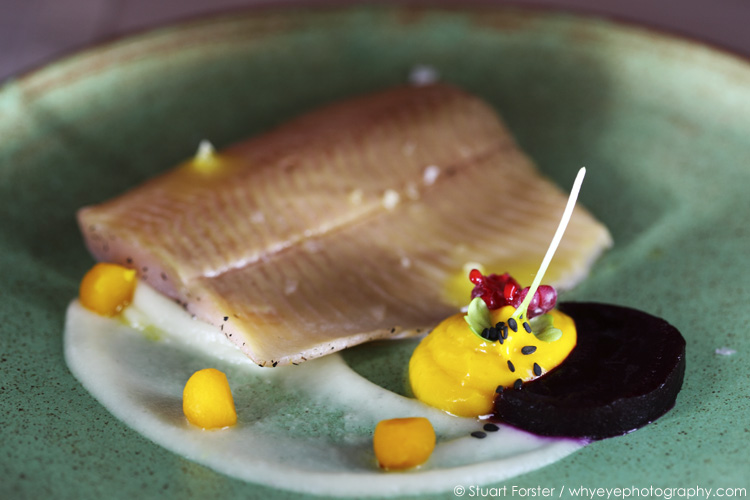Stuart Forster interviews chef Sten Fischer in Weimar, Germany, for an introduction to Thuringian cuisine.
“I try to introduce a regional touch to modern cuisine,” says chef Sten Fischer as we sit chatting in one of the dining rooms of the Alt Weimar restaurant.
A framed photograph of the architect Walter Gropius peers down at us from one of the dark, wood-panelled walls. Almost a century ago, when this place was still a pub and the German city of Weimar was the base of the fledgling Bauhaus movement, Gropius used to drink here with the likes of Paul Klee.
Close to the city’s heart
History and heritage, rather than cuisine, tend to draw people to Weimar’s Altstadt (meaning ‘Old Town’). The Alt Weimar was a two-minute from the Goethe and Schiller statue on Theaterplatz, the spot commonly regarded as the city’s heart.
Nowhere in Weimar, it seems, is complete without at least some distant connection to Johann Wolfgang von Goethe. On the way in I noticed a plaque celebrating that Rudolf Steiner, who conducted research into the author and statesman’s life, lived in the building from 1892 to 1896. The Alt Weimar opened in 1909.
A hearty regional dining tradition
“Thuringia isn’t known for high cuisine. Thuringia is known for big plates and large portions but not as a culinary stronghold,” admits Fischer, who is doing what he can to change perceptions.
He hails from nearby Erfurt and returned to the region in 2007. After learning his trade in the early 1990s he spent time in the kitchens of the Europa and Aida cruise ships then worked at the Fischereihafen Restaurant in Hamburg before heading to Austria for six years. He cooked for Michael Douglas in Bermuda then returned to Germany for the 2006 FIFA World Cup, where he was the chef of the VIP kitchen in Cologne. The diners, he tells me, included Robbie Williams and Posh Spice.
“We try to give a message and show that people can enjoy regional cuisine and high-level regional products at a sensible price. We also want to show to tourists and guests that Weimar is not just about Goethe and Schiller but is also a culinary destination,” says the chef, who is dressed in black.
Local ingredients and game meat
That doesn’t mean that all of Fischer’s ingredients are sourced locally. “I’d say about two-thirds of what we cook here is regional and a third is from elsewhere as we need to give ourselves the possibility to offer seafood – lobster and suchlike – because our guests demand that at this level,” he explains.
“What would my regional signature dish be?” he asks rhetorically, anticipating one of my next questions.
“We have our own hunter. We have wonderful venison, boar and mouflon. Mouflon goes very well with sea buckthorn and carrots. We also use regional taste bud ticklers like marjoram. Thuringia is renowned for having the best marjoram worldwide so we connect that and put a product on the table so guests say, ‘Wow! That’s Thuringia.’”
Fischer has also begun to grow his own ingredients. “Last year, for the first time, I planted my own potatoes; a huge amount of Sieglinde potatoes. Sieglinde is the oldest German potato variety. It’s a firm potato with lovely yellow flesh and tasty too. However, it’s not round or easy to peel and you have to stick a lot of work in but it’s a wonderful regional product,” explains the chef who also makes use of locally sourced pears, strawberries, blackberries, plums and cherries.
English idea, German production
“There’s a great idea from England called Landshare. If people have land they make it available to growers and receive a share of the harvest. I have a meadow with scattered fruit trees and don’t have the time to take care of it. I’ve connected with Bauhaus University. They look after the land but I receive a quarter of the harvest,” says Fischer enthusiastically.
“There’s also a rent-a-cow scheme. I pay a farmer a monthly fee, say €100, to raise a cow from an old German race that’s similar to Galloway cattle. It has slow-growing meat with a lot of fat. After a year, at the very soonest, it can go to the butcher. We receive all of the meat; it’s great. We can offer cookery courses aimed at men. We use the haunches, fillets and tenderloins and show what you can make from each part – T-bones from this, goulash from that – with an amazing quality of meat.”
Further information
Since this feature was published Alt Weimar has closed.
Learn more about Weimar on the city’s tourist information website.
For further details about the region and country as a while see the Thuringia Tourism and Germany National Tourist Board sites.
Photos illustrating this post are by Why Eye Photography.
If you enjoyed this post why not sign up for the free Go Eat Do newsletter? It’s a hassle-free way of getting links to posts on a monthly basis.
‘Like’ the Go Eat Do Facebook page to see more photos and content.




